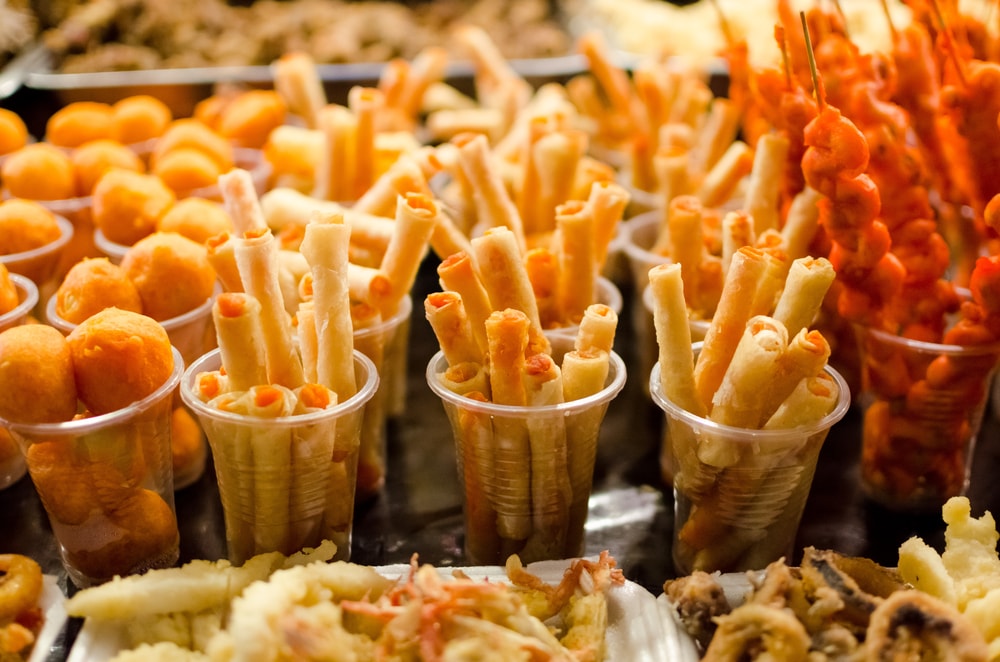Street Food Buying Guide
Street food is one of the best ways to experience a country’s culture. While these makeshift stalls might look risky, street food is often just as safe—if not safer—than restaurants. Ask any experienced adventurer. Still, there are a few basic rules you should know to avoid any problems.
But here are a few things you need to take into considerations.
Temperature
As far as temperature goes food needs to be one of two ways to be safe, hot or cold. It’s simple, below 40F (4C) food bugs won’t grow. Above 140F (60C) they begin to die, then they all die at 160F (71C). Typically street foods (with the exception of fruits and a few others, covered later) are served hot. How hot is the key to food safety, the number you need to remember is 160F (71C). This is the temperature that will kill ALL harmful bugs in your food. Unless you walk around with a meat thermometer in your pocket this may be hard to judge. Just use your head if you see your vendor making a batch and the ingredients are sitting in bubbling oil for several minutes you are most likely to temp.
The size of the pieces is important to how quickly it will cook all the way through. The smaller the piece the faster it will cook. Large or thicker cuts will take much longer than smaller bite-size cuts. If you are unsure ask them to cook it longer, longer is always better when it comes to food bugs. Another way to check is to take the largest or thickest piece and cut (or bite if no knife is available, which is often the case), if the color is consistent from the?inside to outside it’s likely cooked enough. If the meat has the bone, check the color/temperature closest to the bone in the thickest part. This should be the area to get up to temperature last. It can be assumed if this area is properly cooked the rest will be too.
Time
We are going to look at the time in two different ways. First in terms of freshness. In the case of meat, before the animal is taken for its meat the meat is not contaminated. Where the bugs can be introduced is in the butchering and the practices used. Since when evaluating a street food cart you won’t know if this was all done properly we have to assume the meat has some level of bacteria on it. Don’t freak out about this, even the meat in the fancy grocer back at home has some on it too. So to ensure the meat you are about to eat is safe is it has to be cooked to a certain temperature that we talked about above. However, that’s not the end of it. The environment will recontaminate the food even after properly cooking, especially sitting street side. As time passes from cooking, the amount of harmful bugs is growing. Fresh from the grill is the best, an hour or two isn’t ideal but unlikely to get you sick (assuming it’s cooked properly), half a day or overnight has a high potential to get you sick. This is all a numbers game, and since you don’t always know how well the food was cooked, you need to insist on it being fresh.
If a vendor is preparing the food to order, my risk factor drops quickly (provided it gets hot enough). The ones that scare me are the pre-made dishes that are kept warm and then served. How long has that been sitting there? I don’t know, but if it isn’t kept above 140F (60C) you could have some risk. We are going to talk temp again quickly; prime growing temperatures for food bugs are 70F (21C) to 135F (57C). So if they are holding your food in that temp range, they could be incubating the bugs in your meal. Moral of this story, find a cart making it the order or find a busy cart. A popular vendor means two things: 1.) The food isn’t given time to grow enough bacteria to hurt you 2.) That it’s popular for a reason, the food probably tastes GOOD!
Fruit
As a general rule of thumb, if you can peel it, you can eat it. Bananas, oranges, anything with nature’s very own wrapper, you are generally good to go. Any fruit where you eat the skin like most berries, apples, etc. you need to be cautious. Fruits like these need to be disinfected in many countries around the world. Many grocery stores will sell a concentrated disinfectant that mixes with water that will clean the fruits. Personally, I find this to be more of a production than it’s worth and generally just avoid these fruits. Plus, I don’t like the thought of eating chemicals that kill bacteria on my strawberries. Included in the category are also vegetables because they are usually raised in the same soils that contain high levels of bacteria. Lettuce is of high concern because it is generally eaten raw. Other vegetables that are cooked would follow the same rules as the meats above, if it gets hot enough it will be safe. Generally, the bacteria is on the surface and most vegetables when cooked, will reach high enough temperatures.
The final lookout for fruits and smoothies is the equipment. This is not nearly the danger that undercooked foods are but still can get you if the vendor is careless. Things to watch: broken or very old coolers contaminating ingredients, blenders not being broken down and cleaned often, cutting boards used for both cooked and uncooked items. Some of this you may not know, like when stuff was last cleaned, but use some judgment. If the stand looks to be kept in good order, it may give some insight into the rest of the cleaning. One last fruit item that everyone seems to hit is pre-cut fruits. This one goes back to the time issue for me. If it is cut in front of you, I don’t see as much of an issue. On another the hand, if a nice lady approaches you with a bag of warm fruit slices in a little baggie, RUN!
Cold Stuff
The main item that comes to mind here is fruit and smoothies. Do you have two enemies in the battle of safe fruits: Ice and clean equipment (knives, blenders, etc.)? Where ice can get you in trouble is when it is made with bad water, or the ice is stored in an old contaminated cooler. If you can drink the tap water where you are then you have less to worry about. If you can’t?be sure to ask if the ice is made with filtered water, and look for evidence of plastic bags the ice made have been sold in (sometimes if they want to sell it to you, or just don’t understand they may say ‘yes’ it was made with good water or they just say ‘yes’ to everything because they don’t speak any English). This one got me once (I think) while in Costa Rica, making for a very rough second half of the trip. We ordered smoothies for breakfast one day, and from best, we can determine something was funky in them. Watch out for bad ice while drinking too, as it melts into your rum & coke it can get you too (the rum does help some though). The safest drink is typically beer, it can be years old and not hurt you as long as it is sealed.
Always Avoid These Four Things
No matter where you are, it’s in your best interest to always avoid these things:
- Stalls that serve things with ice or local water. The water may be dirty or contain bacteria your body isn’t accustomed to.
- Produce you can’t peel (since it has probably been washed in local water). If it doesn’t have a natural wrapper, stay away.
- Food that isn’t fully cooked.
- Sauces that look like they’ve been sitting out all day and don’t appear to get a lot of use.
These rules can vary depending on where you’re traveling, of course, but they’re good to know anyway.
Lastly, if something seems off about the street food you’re eating, stop putting it in your body. You may be an adventurous person, but now’s not the time to show how brave you are. For example, meat should be too hot to eat the moment it comes off the cooking surface and is handed to you, it shouldn’t look raw inside, and it should never taste or smell like it’s rotting.
If you go to take a bite and the meat is cold or something, toss it and find something else. And if food seems fine going down at first, but starts to give you trouble a minute later, don’t power through the meal. Pray you’ll only get some indigestion and travel on.
Search
Categories
Popular Posts



















Comments: 0
No comments